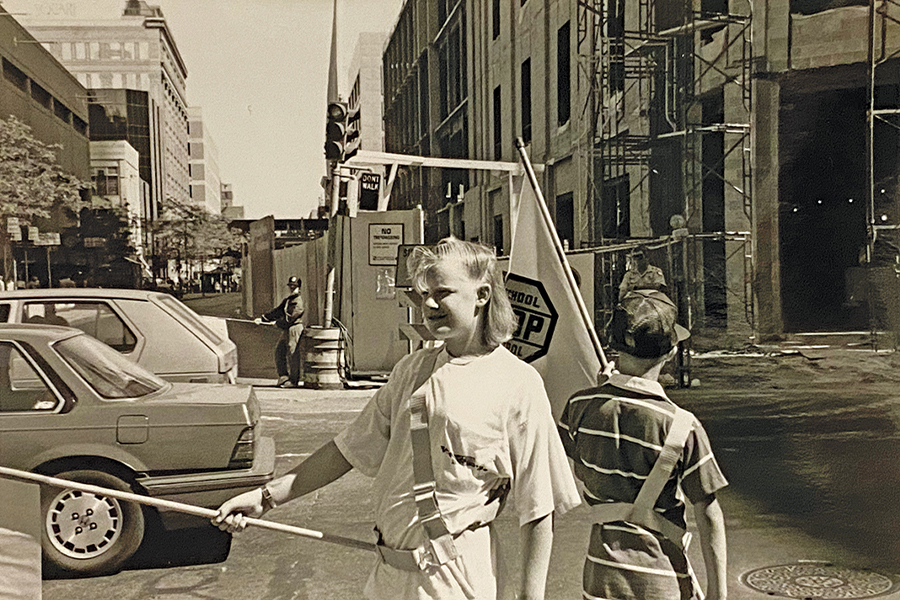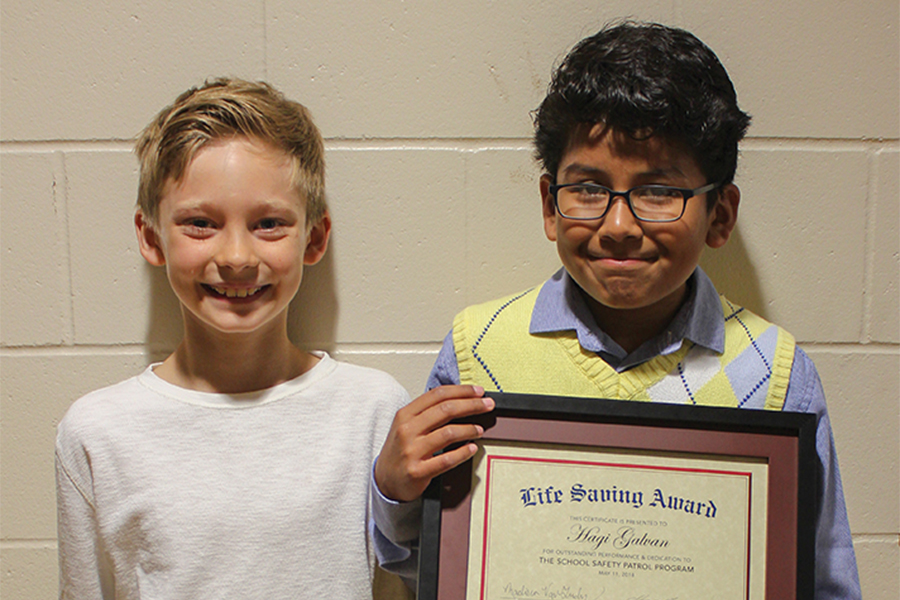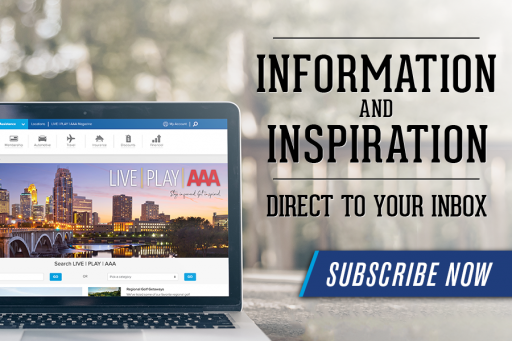A Century of Safety

For some, the School Safety Patrol brings back vivid memories of neon vests, bright flags, sub-zero temps and a swelling feeling of pride. An essential part of growing up and learning responsibility for many children, the School Safety Patrol is a staple in most Hennepin County elementary schools and has been an honored partner of AAA Minneapolis for the past 100 years.
Yes, 2020 marked the centennial of the School Safety Patrol—but like many events over the last year, the joyous, large-scale celebration originally scheduled for September had to be postponed several times. Regardless of when the official festivities occur, the history of the organization and how it continues to serve as an integral part of the community is something to be acknowledged and celebrated.

How it Started
The idea for the school patrol program was originated by Charles M. Hayes, the president of the Chicago Motor Club, in 1920. After witnessing the tragic deaths of several children who were hit by a speeding car at a school crossing, he pledged to do whatever he could to prevent it from happening again. He is credited with building the infrastructure and providing the resources for the original school boy patrols program at AAA clubs across the country. The goal was to protect school-aged children walking to and from school.
The school boy patrollers received extensive safety training that was updated regularly to meet national standards. In the 1930s, three national organizations (AAA, the National Safety Council, and theNational Congress of Parents and Teachers) collaborated to create the Standard Rules for the Operation of School Boy Patrols, which has been used as the blueprint for standards that patrollers use today. The school patrol concept spread quickly to communities and schools nationwide, and even globally. At least 30 other countries, including New Zealand, the Netherlands, England, Germany, and France have all adopted the AAA School Safety Patrol model program. The goal for all safety patrol programs (regardless of location) has remained the same: to reduce traffic injury and death rates among the most vulnerable pedestrian age group, 5 to 14-year-olds.
“AAA School Safety Patrol plays an important role in helping young pedestrians learn and fulfill responsibilities regarding traffic safety,” says Rhonda Shah, AAA’s traffic safety advocacy and community impact manager. “Millions of American children have honorably served their classmates since the program began in the early 1920s, and interest in the program has spread around the world.”

What is the School Safety Patrol?
The School Safety Patrol’s mission is to provide a safer environment and leadership opportunities for millions of school children.
The AAA School Safety Patrol program has more than 670,000 patrollers in 35,000 U.S. schools, making it the largest safety program in the world. The national pedestrian death rate per 100,000 children aged 5to 14 has fallen by 93 percent since 1935 (the first year that records were kept on this issue). Children in this age group used to have the second highest fatality rate of any age group, and today, they have the lowest.
While the organization originally began with school boys, patrols are now comprised of any elementary and middle school student who volunteers or is nominated by a teacher or principal. Patrollers are responsible for directing children, not traffic, before and after school each day. In performing these duties, they teach other students about traffic safety, serve as role models for younger children and become leaders in their community. These young leaders work with supervisors, teachers, adult crossing guards and law enforcement to ensure that they have all of the tools necessary to keep their classmates safe on their way to and from school. In addition to traffic safety, they learn lifelong lessons in leadership and responsibility. Many former patrollers are now notable leaders in their community, ranging from educators, executives and physicians to U.S. presidents, vice presidents, astronauts, governors, Supreme Court justices and Olympians.
Patrol members are required to:
- Complete traffic safety training
- Protect students from dangers and hazards as well as crossing roads to and from school
- Assist bus drivers with safely transporting students to and from school
- Teach fellow students about traffic safety
The symbols of the AAA School Safety Patrol program are the fluorescent, electric-lime belt and shoulder strap (previously orange) worn by patrol members in most communities. A metal badge bearing the AAA emblem is often attached to the shoulder strap at chest level, and the patrol belt conveys the need for caution to motorists and pedestrians. Both are required to be worn when on duty. Schools may also supply ponchos, caps and flags in addition to the Patrol Member Handbook.
AAA’s Involvement
AAA clubs supply training materials, belts, badges and other items needed to operate the program for free. They work in close contact with representatives from each school who run their respective patrol program. AAA promotes and recognizes patrol efforts each year through a series of awards, newsletters, summer camps and scholarships. Patrol members are often appointed by teachers and principals with parent approval, and a teacher typically serves as the patrol advisor and the primary liaison with the local AAA club.
Your local AAA club (including AAA Minneapolis) provides:
- Sponsorship of the program
- Traffic safety education, logistical support and awareness presentations
- Public outreach and recognition
- Resources, including equipment and program guidelines
AAA Minneapolis and its Minneapolis Auto Club Foundation have exclusive sponsorship of the patrol programs in Hennepin County. They serve over 170 schools with approximately 5,000 patrol members. AAA Minneapolis provides all of the programs with the necessary patrol training materials, safety supplies and recognition items completely free of charge. During the program’s local history, there has never been a traffic-related student death at a patrol-guarded crossing.

The AAA School Safety Patrol Lifesaving Medal Award, established in 1949, is the highest lifesaving honor given to members of the School Safety Patrol. The award is presented annually to patrol members who, while on duty, saved the life of someone in imminent danger. There have been only 428 boys and girls from 31 states and the District of Columbia honored with the AAA Lifesaving Medal. Many of the recipients have put their own lives in danger to save others. In 2018, AAA Minneapolis awarded local patroller Hagi Galvan of Lake Harriet Upper Campus School with the AAA Lifesaving Medal for saving a fellow student during a traffic incident. Some noteworthy recipients include U.S. presidents Ford, Johnson, Kennedy and Eisenhower; vice presidents Mondale, Humphrey, Nixon and Barkley; first lady Mamie Eisenhower; justices of the U.S. Supreme Court; cabinet officials; and other dignitaries.
AAA Minneapolis also operates the Minneapolis Auto Club Foundation, a 501(c)(3) nonprofit that is member-funded and was created in 1988. The MAC Foundation provides School Safety Patrol supplies to 160 schools free of charge, gives up to $14,500 in grant money to traffic safety projects, and partners with local police departments, schools, park departments and community members to educate on and advocate for traffic safety. You can support the Minneapolis Auto Club Foundation and the AAA School Safety Patrol Program by making a donation the next time you pay your AAA member fees. Schools interested in beginning or expanding their AAA School Safety Patrol Program can find more information at SchoolSafetyPatrol.AAA.com.





